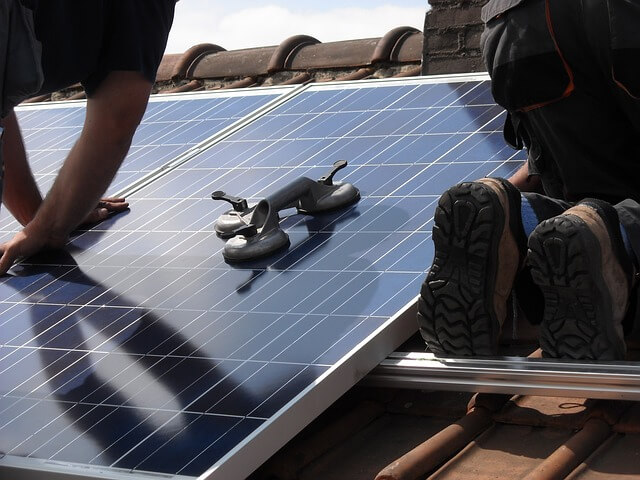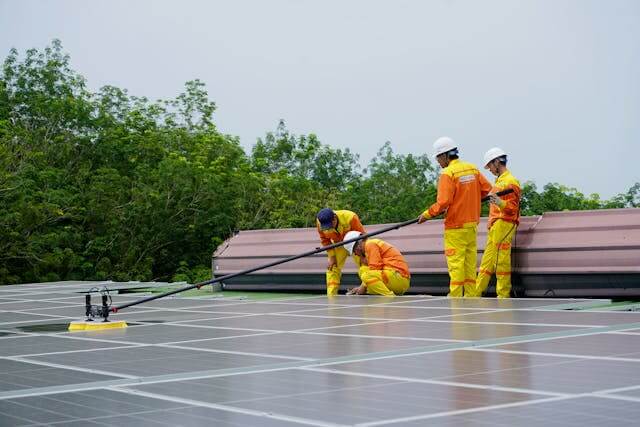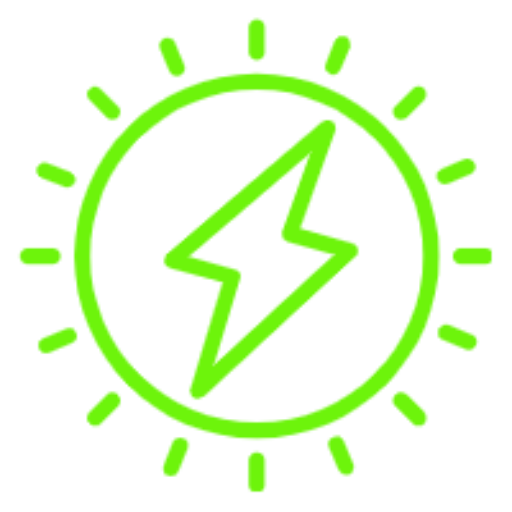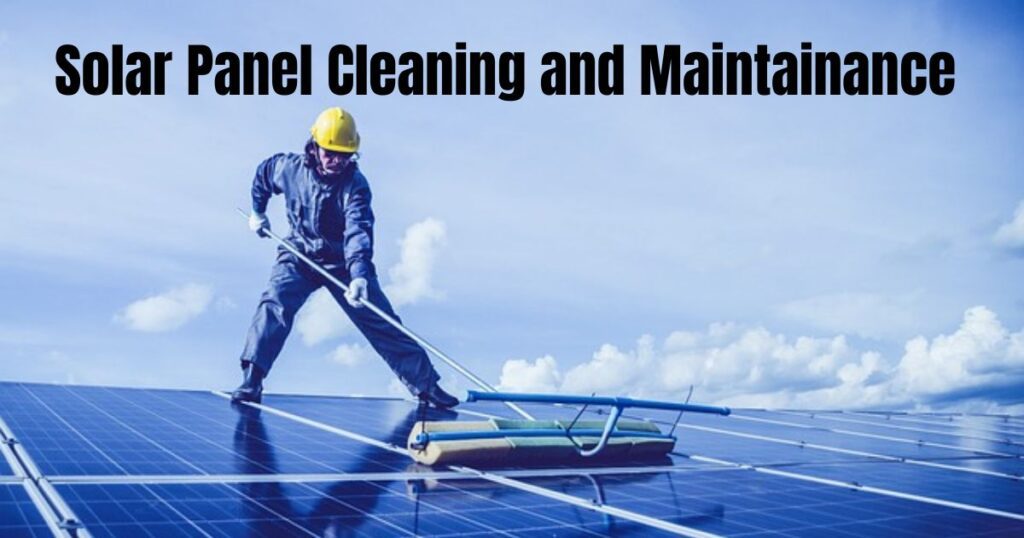Last updated on March 6th, 2025 at 02:38 pm
Solar panel cleaning and maintenance play crucial roles in maximizing the efficiency and longevity of your solar energy system. Regular upkeep ensures that your panels continue to generate optimal energy output by minimizing obstructions to sunlight and addressing potential issues that could impact performance.
From removing dirt and debris to inspecting electrical connections and monitoring system health, proper cleaning and maintenance practices are essential for maximizing the return on your investment in solar energy.
In this article, we’ll discuss the best practices for solar panel cleaning and maintenance, covering everything from safety precautions to specialized cleaning techniques tailored to different environments and weather conditions.
2. Use gentle cleaning methods and avoid abrasive materials to prevent damage to panel surfaces.
3. Inspect electrical connections periodically to ensure proper functioning and safety.
4. Consider weather conditions and environmental factors when scheduling cleaning and maintenance tasks.
5. The cost of DIY cleaning typically ranges from $20 to $50 per cleaning session, while professional cleaning services may cost between $13 and $25 per panel.
Importance of solar panel cleaning and maintenance
Solar panels are a significant investment for homeowners, businesses, and communities seeking to harness renewable energy. However, to ensure optimal performance and longevity, regular cleaning and maintenance are crucial. Here’s why:
Maximizing Energy Production
Solar panels rely on sunlight to generate electricity. Any obstruction to sunlight, such as dirt, dust, bird droppings, or debris accumulation, can significantly reduce their efficiency. Regular cleaning helps maximize energy production by keeping the panels free from such obstructions.
Preserving Efficiency
Over time, dirt and grime can build up on the surface of solar panels, forming a layer that reduces the amount of sunlight reaching the photovoltaic cells. This buildup can lead to decreased efficiency and lower energy output. By regularly cleaning the panels, you can preserve their efficiency and ensure they operate at their maximum potential.
Prolonging Lifespan
Proper maintenance extends the lifespan of solar panels. Accumulated dirt and debris can trap moisture, which may lead to corrosion or other damage to the panels over time. Regular cleaning helps prevent such issues, thereby prolonging the lifespan of the panels and protecting your investment.
Protecting Warranty Coverage
Many solar panel manufacturers require regular maintenance as a condition of their warranty coverage. Failure to adhere to maintenance guidelines could void your warranty, leaving you responsible for any repair or replacement costs. By staying proactive with cleaning and maintenance, you can ensure that your warranty remains valid and protect yourself from unexpected expenses.

Maintenance tips for solar solar panels
- Regular Inspection: Schedule routine inspections of your solar panels to identify any issues early on. Look for signs of damage, such as cracks, chips, or discoloration, as well as any loose connections or mounting hardware.
- Keep Panels Clean: Regularly clean your solar panels to remove dirt, dust, bird droppings, and other debris that can obstruct sunlight and reduce efficiency. Use a soft brush or sponge with mild soap and water to gently scrub the surface, avoiding abrasive materials that could scratch the panels.
- Monitor Performance: Keep track of your solar panel’s performance by monitoring energy production levels. Sudden drops in energy output could indicate a problem with the panels that requires attention.
- Trim Surrounding Vegetation: Trim back any trees, branches, or bushes that may cast shadows on your solar panels, especially during peak sunlight hours. Shading can significantly decrease energy production, so keeping surrounding vegetation trimmed is essential for maximizing efficiency.
- Check for Shading: Periodically check for shading caused by nearby buildings, structures, or other obstructions that may have developed over time. Consider adjusting the positioning or angle of the panels to minimize shading and optimize sunlight exposure.
- Inspect Electrical Components: Inspect the electrical components of your solar panel system, including wiring, inverters, and connectors, for any signs of wear, corrosion, or damage. Ensure all connections are secure and free from debris to maintain optimal performance.
- Protect Against Wildlife: Install measures to protect your solar panels from nesting birds, rodents, or other wildlife that may cause damage or create obstructions. Use bird deterrents, mesh barriers, or other protective devices as needed.
- Follow Manufacturer Guidelines: Adhere to the maintenance guidelines provided by the manufacturer of your solar panels and related components. Follow recommended cleaning methods, schedule regular maintenance checks, and address any issues promptly to ensure warranty coverage and optimal performance.
- Professional Maintenance: Consider hiring a professional solar panel maintenance service to conduct periodic inspections and maintenance tasks, especially for hard-to-reach or larger installations. Professional technicians have the expertise and equipment to identify and address issues effectively.
- Stay Informed: Stay informed about advancements in solar panel technology and maintenance best practices. Keep up-to-date with industry news, resources, and recommendations to ensure you’re employing the most effective maintenance strategies for your solar panel system.
Solar panel cleaning in different environments and weather conditions

How to clean solar panels? step-by-step process
Inspecting the Panels
- Visual Examination: Begin by visually inspecting the solar panels for any visible dirt, debris, or signs of damage, such as cracks, scratches, or discoloration. Use a pair of safety glasses to protect your eyes during the inspection.
- Check for Shading: Look for any obstructions or shading caused by nearby objects, vegetation, or debris that may affect the panel’s performance. Note any areas that require special attention during the cleaning process.
Rinsing with Water
- Pre-Rinse: Use a hose with a gentle spray attachment or a bucket of clean water to pre-rinse the solar panels. This helps loosen and remove surface debris, making it easier to clean the panels effectively.
- Thorough Rinse: Thoroughly rinse the panels with clean water, ensuring to cover the entire surface area. Pay special attention to corners, edges, and areas where dirt or debris may be concentrated.
Using a Gentle Cleaning Solution
- Prepare Cleaning Solution: Mix a mild soap or detergent with water in a bucket to create a gentle cleaning solution. Avoid using harsh chemicals or abrasive cleaners that could damage the panels.
- Apply Cleaning Solution: Dip a soft brush or sponge into the cleaning solution and gently scrub the surface of the solar panels in a circular motion. Focus on areas with stubborn stains or buildup, but be careful not to apply excessive pressure to avoid scratching the panels.
Wiping and Drying the Panels
- Wipe Away Soap Residue: After scrubbing with the cleaning solution, use a squeegee or soft cloth to wipe away any soap residue from the panels. Ensure thorough removal to prevent the formation of water spots or streaks.
- Dry Panels: Allow the solar panels to air dry naturally or use a clean, dry cloth to gently dry the surface. Avoid using abrasive materials or wiping in a back-and-forth motion, as this may cause scratches or damage to the panels.
Final Inspection
- Visual Check: Once the panels are clean and dry, conduct a final visual inspection to ensure all dirt, debris, and soap residue have been removed. Check for any remaining stains or areas that may require additional cleaning.
- Test Performance: Turn on the power supply to the solar panel system and monitor its performance to ensure there are no issues following the cleaning process. Note any changes in energy production or efficiency that may require further investigation.
How frequently do solar panels need maintenance?

